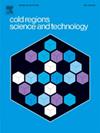Monitoring evolutionary damage of bended concrete beams subjected to freeze-thaw cycling through piezoelectric-enabled wave propagation method
IF 3.8
2区 工程技术
Q1 ENGINEERING, CIVIL
引用次数: 0
Abstract
Tunnels in cold regions are often subjected to freeze-thaw cycling, which poses a great challenge to a large number of tunnels in operation or to be built in these regions. Therefore, structural health monitoring (SHM) for lining concrete in cold regions is essential to ensure the safety and long-term operation of tunnels. In this study, the wave propagation method (WPM) is applied for the first time to monitor the cyclic freeze-thaw damage of lining concrete. First of all, the failure behaviors of concrete beams subjected to the coupling effect of flexural loading and freeze-thaw cycling are investigated. Particularly, the authors propose a refined numerical model to simulate the freeze-thaw cycling damage process of concrete beams considering the ice-water phase transition and concrete elastoplastic damage. Based on the numerical results, the internal damage expansion and flexural strength attenuation of concrete beams are revealed. Furthermore, the dynamic attenuation characteristics of stress waves are analyzed by using the wavelet packet decomposition and continuous wavelet transform to reveal. In addition, the WPM-based energy index is proposed to characterize the freeze-thaw damage degree of the lining concrete. A strong correlation is found between the stress wave signal and freeze-thaw damage, with a favorable correlation coefficient of 0.932, suggesting the excellent performance of the WPM in assessing the freeze-thaw damage of lining concrete. This research sufficiently manifests the applicability of the WPM method to monitoring the freeze-thaw damage within cold regional tunnel linings.
通过压电波传播方法监测受冻融循环影响的弯曲混凝土梁的进化损伤
寒冷地区的隧道经常受到冻融循环的影响,这给这些地区大量正在运营或即将建设的隧道带来了巨大挑战。因此,寒冷地区衬砌混凝土的结构健康监测(SHM)对于确保隧道的安全和长期运营至关重要。本研究首次采用波传播法(WPM)监测衬砌混凝土的循环冻融破坏。首先,研究了混凝土梁在挠曲荷载和冻融循环耦合作用下的破坏行为。特别是,考虑到冰水相变和混凝土弹塑性破坏,作者提出了一个精细的数值模型来模拟混凝土梁的冻融循环破坏过程。基于数值结果,揭示了混凝土梁的内部损伤扩展和抗弯强度衰减。此外,利用小波包分解和连续小波变换分析了应力波的动态衰减特性。此外,还提出了基于 WPM 的能量指数来表征衬砌混凝土的冻融破坏程度。研究发现,应力波信号与冻融破坏之间具有很强的相关性,相关系数高达 0.932,表明小波包分解技术在评估衬砌混凝土冻融破坏方面具有优异的性能。这项研究充分体现了 WPM 方法在监测寒冷地区隧道衬砌冻融破坏方面的适用性。
本文章由计算机程序翻译,如有差异,请以英文原文为准。
求助全文
约1分钟内获得全文
求助全文
来源期刊

Cold Regions Science and Technology
工程技术-地球科学综合
CiteScore
7.40
自引率
12.20%
发文量
209
审稿时长
4.9 months
期刊介绍:
Cold Regions Science and Technology is an international journal dealing with the science and technical problems of cold environments in both the polar regions and more temperate locations. It includes fundamental aspects of cryospheric sciences which have applications for cold regions problems as well as engineering topics which relate to the cryosphere.
Emphasis is given to applied science with broad coverage of the physical and mechanical aspects of ice (including glaciers and sea ice), snow and snow avalanches, ice-water systems, ice-bonded soils and permafrost.
Relevant aspects of Earth science, materials science, offshore and river ice engineering are also of primary interest. These include icing of ships and structures as well as trafficability in cold environments. Technological advances for cold regions in research, development, and engineering practice are relevant to the journal. Theoretical papers must include a detailed discussion of the potential application of the theory to address cold regions problems. The journal serves a wide range of specialists, providing a medium for interdisciplinary communication and a convenient source of reference.
 求助内容:
求助内容: 应助结果提醒方式:
应助结果提醒方式:


